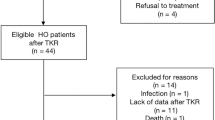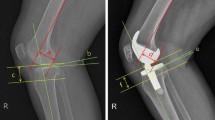Abstract
Introduction
Heterotopic ossification (HO) following primary total knee arthroplasty is a rare complication and may be symptomatic if massive enough. Especially the range of motion (ROM) is essential for the function and durability of the implant. The aim of the study was to evaluate the influence of HO on ROM using clinical and radiological parameters.
Materials and methods
We reviewed 191 primary total knee arthroplasties according to the clinical preoperative and postoperative parameters of the Knee Society Score with special interest paid to the ROM. Standardized radiographs were taken at three levels and the implant position compared. The patients were divided into group 1 (with HO) and group 2 (without HO). The clinical and radiological parameters were compared.
Results
We found an incidence of HO in 14.1% (n=27). Group 1 showed a decreased ROM postoperatively (p=0.003) and worse flexion contracture (p=0.04) compared with group 2. The evaluated radiological parameters showed no significant difference between the two groups.
Conclusion
We found a significant limitation of ROM because of HO in our study. We found no correlation between HO and component alignment or component position. Local irritation has to be considered the main reason for limited ROM.


Similar content being viewed by others
References
Austin KS, Siliski JM (1995) Symptomatic heterotopic ossification following total knee arthroplasty. J Arthroplasty 10:695–698
Barrack RL, Brumfield CS, Rorabeck CH, Cleland D, Myers L (2002) Heterotopic ossification after revision total knee arthroplasty. Clin Orthop 404:208–213
Bellemans J, Claerhout P, Eid T, Fabry G (1999) Severe heterotopic ossifications after total knee arthroplasty. Acta Orthop Belg 65:98–101
Brooker AF, Bowerman JW, Riley LH (1973) Ectopic ossification following total hip replacement. J Bone Joint Surg Am 55:1629
Chidel MA, Suh JH, Matejeczyk MB (2001) Radiation prophylaxis for heterotopic ossification of the knee. J Arthroplasty 16:1–6
Daluga D, Lombardi AV Jr, Mallory TH, Vaughn BK (1991) Knee manipulation following total knee arthroplasty. J Arthroplasty 6:119–128
Eulert J, Knelles D, Barthel T (1997) Heterotope Ossifikationen. Unfallchirurg 100:667–674
Ewald FC (1989) The Knee Society total knee arthroplasty roentgenographic evaluation and scoring system. Clin Orthop 248:9-12
Figgie HE, Goldberg VM, Heiple KG, Moller HS, Gordon NH (1986) The influence of the tibial-patellofemoral location on function of the knee in patients with posterior stabilized condylar knee prosthesis. J Bone Joint Surgery Am 68:1035–1040
Figgie HE III, Goldberg VM, Figgie MP (1986) The incidence and significance of heterotopic ossification following total knee arthroplasty. Adv Orthop Surg 10:12–17
Freedman EL, Freedman DM (1996) Heterotopic ossification following total knee arthroplasty requiring surgical excision. Am J Orthopedics 25:559–561
Furia JP, Pellegrini VD Jr (1995) Heterotopic ossification following primary total knee arthroplasty. J Arthroplasty 10:413–419
Harwin SF, Stein AJ, Stern RE, Kulick RG (1993) Heterotopic ossification following primary total knee arthroplasty. J Arthroplasty 8:113–116
Hasegawa M, Ohashi T, Uchida A (2002) Heterotopic ossification around distal femur after total knee arthroplasty. Arch Orthop Trauma Surg 122:274–278
Insall JN, Dorr LD, Scott RD, Scott WN (1989) Rationale of the Knee Society clinical rating system. Clin Orthop 248:13–14
Iorio R, Healy WL (2002) Heterotopic ossification after hip and knee arthroplasty: risk factors, prevention, and treatment. J Am Acad Orthop Surg 10:409–416
Keblish PA, Varma AK, Greenwald AS (1994) Patellar resurfacing or retention in total knee arthroplasty. J Bone Joint Surg Br 76:930–937
Lotke PA, Ecker ML (1977) Influence of positioning of prosthesis in total knee replacement. J Bone Joint Surg Am 59:77
Maloney WJ, Schurman DJ (1992) The effects of implant design on range of motion after total knee arthroplasty. Clin Orthop 278:147–152
Nollen AJG, Slooff TJJH (1973) Para-articular ossifications after total hip replacement. Acta Orthop Scand 44:230–241
Papagelopoulos PJ, Sim FH (1997) Limited range of motion after total knee arthroplasty: etiology, treatment, and prognosis. Orthopedics 20:1061–1065
Rader CP, Barthel T, Haase M, Scheidler M, Eulert J (1997) Heterotopic ossification after total knee arthroplasty. Acta Orthop Scand 68:46–50
Ritter MA, Stringer EA (1979) Predictive range of motion after total knee replacement. Clin Orthop 143:115–119
Toyoda T, Matsumoto H, Tsuji T, Kinouchi J, Fujikawa KJ (2003) Heterotopic ossification after total knee arthroplasty. Arthroplasty 18:760–764
Walker PS, Garg A (1991) Range of motion in total knee arthroplasty. Clin Orthop 262:227–235
Author information
Authors and Affiliations
Corresponding author
Rights and permissions
About this article
Cite this article
Sterner, T., Saxler, G. & Barden, B. Limited range of motion caused by heterotopic ossifications in primary total knee arthroplasty: a retrospective study of 27/191 cases. Arch Orthop Trauma Surg 125, 188–192 (2005). https://doi.org/10.1007/s00402-005-0797-3
Received:
Published:
Issue Date:
DOI: https://doi.org/10.1007/s00402-005-0797-3




